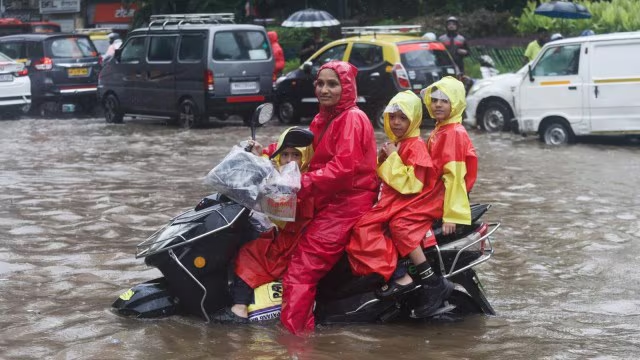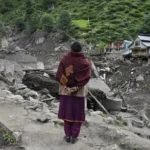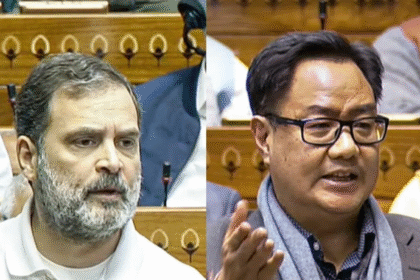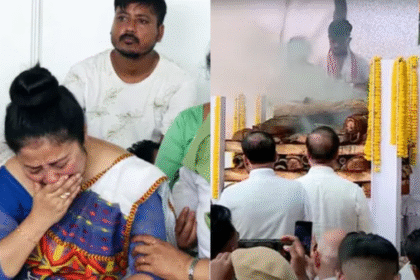Mumbai Weather Today Live Updates: Rains, Traffic, Waterlogging, IMD Alerts
The Monsoon’s Grip on Mumbai
Mumbai, India’s bustling financial capital, once again finds itself at the mercy of torrential monsoon rains. The rhythm of life in the city has always been deeply intertwined with the seasonal downpour, but 2025 has brought an even more pressing urgency to its annual battle against waterlogging, traffic chaos, and the strain on urban infrastructure.
On August 16, heavy rains lashed the city overnight and continued through the morning, leaving several arterial roads submerged. Vehicles crawled at a snail’s pace across key junctions, while thousands of office-goers and students struggled to navigate waist-deep water in low-lying areas. For Mumbaikars, this was not an unfamiliar sight, but each year the magnitude of disruption seems to grow, echoing a harsh reminder of the city’s infrastructural vulnerabilities.
Red Alert by IMD
The India Meteorological Department (IMD) issued a red alert, warning of extremely heavy rainfall over the next 24 hours. This alert covers both the city and its suburban belts, with warnings of potential flash floods, power disruptions, and transport breakdowns. The IMD cautioned citizens to avoid unnecessary travel and urged local authorities to remain on high alert.
The alert triggered an immediate response from the Brihanmumbai Municipal Corporation (BMC). Emergency teams were deployed across sensitive zones, pumping machines were readied, and disaster control helplines were activated. Yet, as the water levels rose in areas like Sion, Andheri Subway, Kurla, and Chembur, frustration spilled over on social media where residents questioned whether enough had been done in advance to mitigate the crisis.
Traffic and Commuter Struggles
Mumbai’s lifeline—the suburban train network—suffered severe delays as water flooded tracks between Kurla and Dadar. Several trains were canceled, and others crawled at reduced speeds, throwing thousands of daily commuters into uncertainty. BEST buses too faced diversions, leaving long queues of stranded passengers.
On the road, the Western Express Highway and Eastern Express Highway witnessed gridlocks, as stranded vehicles stalled in flooded patches. Two-wheelers, in particular, bore the brunt of the downpour, with many riders forced to abandon their bikes and wade through knee-deep water.
In areas like King’s Circle, Saki Naka, and Milan Subway, visuals of stranded taxis and auto rickshaws painted a grim picture. Parents expressed concerns over children returning from schools as waterlogging outside campuses delayed pick-ups.
The Human Impact
Beyond the inconvenience, the rains brought real danger. Local hospitals reported a rise in cases of injuries due to slips and falls on slippery pavements. The civic health department also warned of the heightened risk of water-borne diseases such as leptospirosis and gastroenteritis in the coming days.
For many daily-wage workers, the rains meant lost wages, as reaching workplaces became impossible. For slum dwellers near Mithi River and other vulnerable zones, the fear of water entering homes loomed large. Several families were seen placing sandbags at entrances to prevent flooding, while NGOs mobilized volunteers to distribute food packets in flood-hit pockets.
Mumbai’s Endless Monsoon Battle
Year after year, Mumbai’s monsoon stories repeat themselves—flooded roads, disrupted trains, traffic snarls, stranded passengers, and frantic social media posts calling for help. Urban planners point out that despite repeated promises, the city’s stormwater drainage system remains inadequate to handle the sheer volume of rainfall it receives during peak monsoon days.
Experts have long emphasized the need for a long-term urban resilience plan, involving modern drainage infrastructure, preservation of natural water bodies, and better coordination among civic agencies. However, ground realities suggest that Mumbai continues to patch its problems with temporary fixes rather than structural reforms.
As the rain continues, the question looms large: Will Mumbai ever break free from this cycle of monsoon misery, or is this the price it pays for its unplanned urban growth?
Schools and Colleges Face Disruptions
The heavy rains didn’t just slow down traffic—it also disrupted Mumbai’s education sector. Several schools across the city, particularly in low-lying areas of Kurla, Dadar, and Andheri, declared half-days as parents struggled to pick up their children. In some suburbs like Thane and Navi Mumbai, local authorities advised schools to remain shut altogether, citing safety concerns.
Colleges faced similar issues. Many institutions, especially those located near the central and western railway lines, saw significantly lower attendance. Students traveling long distances were unable to reach campuses due to waterlogged tracks and halted bus services. Some colleges swiftly shifted to online classes for the day, reminding Mumbaikars of the pandemic era when digital platforms had temporarily replaced physical classrooms.
For parents, the uncertainty was nerve-wracking. Social media was flooded with frantic posts asking about school closures, bus routes, and safety updates. WhatsApp groups became lifelines, as parents shared real-time information on routes and rainfall intensity.
Impact on Businesses and Markets
Mumbai, as India’s financial hub, never truly stops. But the rains tested even its resilience. Offices in Nariman Point, Bandra Kurla Complex (BKC), and Lower Parel reported lower attendance as employees were either stranded or forced to work from home. Many companies quickly activated remote working policies, allowing staff to log in virtually to maintain business continuity.
The stock market, meanwhile, carried on with its usual rhythm, though trading floors in Mumbai were quieter than usual. Brokers admitted that several colleagues couldn’t make it to office due to travel disruptions. Despite this, digital trading ensured business continuity, showing how financial markets have adapted to extreme weather conditions.
Local businesses, however, bore the brunt. Street vendors, shopkeepers, and small eateries faced sharp losses as footfall declined dramatically. Many were forced to shut down early, fearing that worsening rains would make it impossible to return home later. For daily wage earners, one missed day of work meant a direct blow to household income.
Citizens’ Voices and Social Media Reactions
As always, Mumbaikars turned to social media to share their stories, frustrations, and appeals for help. X (formerly Twitter) and Instagram feeds were filled with images of submerged cars, office-goers wading through waist-deep water, and humorous memes about the city’s “annual swimming festival.”
Yet, amid the humor, serious concerns were raised. Citizens questioned whether the Brihanmumbai Municipal Corporation (BMC) had invested adequately in pre-monsoon preparedness. Many pointed out that drains had been left clogged despite repeated assurances of cleaning drives. Others tagged local authorities, sharing live videos of flooding, hoping for immediate intervention.
Community spirit, however, shone through. Residents in high-rise societies opened their basements and parking spaces to shelter stranded bikers. Volunteers distributed tea, biscuits, and raincoats to those stuck in traffic. Radio jockeys kept listeners informed with real-time traffic updates, proving once again that in moments of crisis, Mumbai’s resilience and solidarity come alive.
BMC and Government’s Official Response
The BMC issued multiple updates throughout the day, assuring citizens that water pumps were deployed in 200 sensitive spots and that disaster management teams were on the ground. The civic body also highlighted that it had tied up with the IMD for real-time rainfall tracking to take faster action in flood-prone zones.
Maharashtra’s Chief Minister, in a televised briefing, acknowledged the severity of the rains and directed civic agencies to prioritize the safety of vulnerable communities, especially slum dwellers near the Mithi River and coastal belts. He appealed to citizens not to panic and assured them that adequate rescue arrangements had been made.
At the same time, opposition leaders criticized the government, pointing to repeated flooding at the same locations year after year. They argued that despite budget allocations, structural solutions like stormwater drainage upgrades and river desilting remained incomplete.
The Unanswered Questions
Even as authorities issued reassurances, many Mumbaikars couldn’t shake off a sense of déjà vu. Why do the same areas flood every year? Why does the suburban train network collapse despite being called the city’s lifeline? Why are citizens forced to risk their safety while commuting, instead of receiving proactive alerts and preventive measures?
Experts argue that Mumbai’s monsoon problem isn’t just about heavy rainfall—it’s about planning. The city has grown rapidly, often ignoring natural drainage systems like mangroves, wetlands, and rivers. Urbanization has eaten into water absorption zones, leaving rainwater with no place to go except city roads. Unless these systemic issues are addressed, monsoon chaos may continue to repeat like clockwork.
The Legacy of Mumbai’s Monsoon
Mumbai’s relationship with the monsoon is both celebrated and feared. On one hand, the rains symbolize romance, poetry, cinema, and cultural nostalgia. On the other, they bring with them recurring nightmares of floods, traffic standstills, and infrastructural breakdowns. Every year, residents brace themselves, knowing that while the rain is essential for life, it can also paralyze the city within hours.
The city’s geography plays a major role in this duality. Built on reclaimed land and surrounded by the Arabian Sea, Mumbai is essentially a collection of low-lying islands stitched together. The natural drainage system that once carried excess rainwater into creeks and mangroves has been significantly reduced over decades of unplanned construction. As a result, rainfall that once seamlessly flowed out now accumulates on roads and railway tracks.
Historic Floods That Changed Mumbai
To understand today’s chaos, one must revisit the city’s history of devastating floods.
- 26 July 2005: Considered Mumbai’s darkest monsoon day, the city received 944 mm of rainfall in just 24 hours—the highest ever recorded. Over 1,000 people lost their lives, trains and buses were submerged, and thousands were stranded overnight. The day is etched into collective memory as a reminder of how vulnerable the city is to extreme weather.
- 2017 Floods: Once again, Mumbai came to a standstill with torrential rains reminiscent of 2005. Waterlogging paralyzed transport, and parts of the city were cut off for hours. Authorities admitted that the drainage system had not been upgraded despite repeated promises.
- 2019 Monsoon Flooding: Multiple days of continuous rainfall led to the collapse of bridges, building wall collapses, and severe disruptions in both air and rail travel.
- 2021–2022 Flood Events: Even moderate rainfall events in recent years triggered flooding in areas like Sion, Chembur, and Kurla, proving that systemic solutions remain incomplete.
Each of these incidents forced authorities to announce new measures, but implementation has lagged, leaving citizens skeptical of official assurances.
Scientific Data and IMD’s Role
The India Meteorological Department (IMD) has become a crucial player in helping Mumbai prepare for extreme weather. With advancements in technology, the IMD now provides short-range, medium-range, and long-range forecasts using Doppler radars and satellite imagery.
For the current spell, the IMD issued yellow and orange alerts, signaling heavy to very heavy rainfall in isolated parts of Mumbai. These alerts are color-coded to help authorities plan responses:
- Yellow: Be updated, conditions may worsen.
- Orange: Be prepared, heavy rain likely to disrupt normal life.
- Red: Take action, extremely heavy rain expected.
Despite these warnings, the challenge lies in communicating them effectively to the public. Many citizens remain unaware or indifferent to such alerts, either due to lack of outreach or fatigue from repeated warnings. Experts stress that early warning systems must be integrated with transport services, schools, and workplaces to truly save lives.
Neighborhoods Most Affected by Waterlogging
Year after year, certain areas of Mumbai emerge as the most vulnerable to flooding. These include:
- Sion, King’s Circle, and Matunga: Known for chronic waterlogging due to their bowl-like geography.
- Kurla and Chembur: Thickly populated suburbs where poor drainage and encroachments worsen the situation.
- Andheri Subway: Infamous for turning into a temporary pond with even moderate rainfall.
- Dharavi and Mithi River Belt: Settlements around the Mithi River face recurrent flooding due to illegal construction and poor waste management.
- Western Express Highway: A lifeline for commuters, often slows to a crawl due to submerged service roads.
These “chronic flooding spots” are well-known to both citizens and authorities, yet long-term solutions remain elusive. Critics argue that unless the city invests in sustainable urban drainage, these same areas will flood every year, regardless of how much rain falls.
Comparison with Other Indian Cities
Mumbai isn’t alone in its struggle. Several other Indian cities have faced similar monsoon challenges, though on different scales.
- Chennai (2015): Witnessed catastrophic floods due to heavy rains and poor water management, with large-scale displacement of residents.
- Kolkata: Faces frequent waterlogging during monsoons due to outdated drainage, though pumping stations have improved in recent years.
- Bengaluru: Once considered climate-friendly, now experiences urban floods as lakes and wetlands have been encroached upon.
What makes Mumbai unique, however, is its scale. As the country’s financial capital with a population of over 20 million, disruptions here ripple across India’s economy. From stock market slowdowns to flight cancellations, the consequences of a flooded Mumbai go far beyond city limits.
Lessons Unlearned
Every monsoon brings fresh debates, promises, and temporary fixes. Pumping stations are installed, desilting drives are conducted, and task forces are deployed. Yet the larger question remains: why does Mumbai continue to face the same challenges? Experts suggest several reasons:
- Short-term political focus instead of long-term planning.
- Encroachment on natural flood buffers like mangroves and wetlands.
- Outdated drainage systems not designed for today’s extreme rainfall.
- Lack of integration between urban planning and climate adaptation policies.
Without addressing these structural issues, rainfall—no matter how predictable—will continue to overwhelm the city.
Climate Change and Intensifying Rainfall
One of the most pressing realities shaping Mumbai’s monsoon today is climate change. Meteorologists and environmentalists have consistently warned that the city is experiencing not just more rainfall, but shorter, sharper, and more intense bursts of precipitation.
Unlike earlier decades where rain was spread evenly over weeks, Mumbai now witnesses episodes where 200–300 mm of rain falls in just a few hours. Such sudden downpours overwhelm the drainage system, leading to flash floods and chaos. Scientists attribute this to:
- Warmer Arabian Sea temperatures, fueling stronger monsoon currents.
- Shifts in wind circulation patterns, concentrating rainfall over smaller areas.
- Urban heat island effect, where the city’s concrete surfaces trap heat, altering local weather patterns.
The consequence is that Mumbai’s monsoon is no longer predictable in its old rhythm. Instead, the city faces extremes—either long dry spells followed by cloudbursts, or continuous heavy rainfall with very little let-up.
Rising Sea Levels and Coastal Risks
As a coastal megacity, Mumbai is directly threatened by rising sea levels. The Intergovernmental Panel on Climate Change (IPCC) has identified Mumbai as one of the world’s most vulnerable cities to coastal flooding. Combined with high tides, storm surges, and heavy rains, the rising sea creates a perfect recipe for disaster.
Neighborhoods like Worli, Dadar, Marine Drive, and Versova face higher risks during high tide when rainfall coincides with seawater pushing inland. Once seawater enters drainage lines, even powerful pumps fail to clear floodwaters. Projections suggest that by 2050, parts of Mumbai’s coastline could be permanently inundated if mitigation efforts are not prioritized.
Urban Planning Flaws
While nature plays its role, much of Mumbai’s flooding is man-made. The city’s urban planning flaws have turned seasonal rains into recurring crises. Some of the key failures include:
- Encroachment on Mangroves and Wetlands
- Mangroves once acted as natural flood buffers, absorbing excess water.
- In areas like Goregaon, Malad, and Navi Mumbai, rampant construction has destroyed large portions of mangrove cover.
- With natural sponges gone, water has no place to recede.
- Reclamation of Land Without Drainage Planning
- Entire business districts, such as Bandra-Kurla Complex (BKC), were developed on low-lying marshland.
- Despite modern infrastructure, BKC floods almost every monsoon, highlighting flawed design.
- Outdated Drainage System
- Much of Mumbai’s stormwater drainage network was built in the British era, designed for 25 mm per hour of rainfall.
- Today, the city often witnesses 80–100 mm per hour, making the old system grossly inadequate.
- Unregulated Urbanization
- From high-rises to slum settlements, construction continues with little regard for carrying capacity.
- Asphalt roads and concrete pavements reduce groundwater absorption, forcing all water onto already choked drains.
The Case of the Mithi River
Perhaps nothing symbolizes Mumbai’s urban planning failure better than the Mithi River. Once a thriving water channel connecting Powai and Vihar lakes to Mahim Creek, the river has now been reduced to a polluted drain. Industrial waste, sewage, and garbage choke its flow.
During the 2005 floods, the overflowing Mithi River was a major factor behind widespread inundation. In the aftermath, the government promised to clean and widen the river channel. While some work has been carried out, illegal encroachments continue, limiting the river’s role as a flood-carrying channel.
Government Efforts and Limitations
Over the years, several measures have been introduced to make Mumbai more resilient:
- BRIMSTOWAD Project (Brihanmumbai Storm Water Disposal System): Aimed at upgrading drainage to handle higher rainfall. Progress has been slow, with only partial implementation.
- Pumping Stations: Installed in Worli, Haji Ali, and other areas to push out excess rainwater during high tide. These have helped but are not sufficient citywide.
- Early Warning Systems: Integration of IMD alerts with municipal control rooms has improved disaster preparedness.
- Smart City Plans: Envision flood-resilient infrastructure, though execution remains far behind schedule.
Despite these efforts, critics argue that implementation gaps, political delays, and corruption undermine progress. The recurring floods every monsoon testify to systemic weaknesses.
Expert Solutions for a Resilient Future
Urban planners, climate scientists, and activists propose several long-term solutions:
- Restoration of Natural Buffers: Protect mangroves, wetlands, and floodplains to absorb excess rainfall.
- Green Infrastructure: Promote rainwater harvesting, permeable pavements, and green rooftops.
- Drainage Upgrades: Modernize the network to handle 100+ mm/hour rainfall capacity.
- River Restoration: Clean and widen the Mithi and other nullahs to act as functional water channels.
- Integrated Coastal Protection: Build sea walls and storm barriers while avoiding ecological damage.
- Decentralized Planning: Involve local communities and wards in flood-preparedness, instead of relying only on top-down policies.
Global Lessons for Mumbai
Mumbai can learn from international cities that have tackled similar challenges:
- Tokyo: Built massive underground floodwater tunnels to protect the city from typhoon rains.
- Rotterdam (Netherlands): Adopted “living with water” policies, creating water plazas and floating neighborhoods.
- Singapore: Transformed polluted rivers into clean waterways with sustainable urban drainage systems.
For Mumbai, such global practices need to be adapted to its own geography, density, and socio-economic realities.
The Human Cost of Inaction
Beyond technical discussions, it is important to recognize the human dimension of Mumbai’s monsoon. For middle-class residents, flooding means cars damaged, office hours lost, and commutes extended. For the poor, especially slum dwellers, it means homes destroyed, belongings lost, and health hazards from contaminated water.
Waterborne diseases like leptospirosis, dengue, and gastroenteritis rise sharply during the monsoon, hitting vulnerable populations hardest. For them, every rainfall warning is not just an inconvenience but a potential disaster.
Also Read : INDIA bloc Mulls Impeachment Notice Against CEC Over ‘Vote Chori’ Claims; EC Demands Proof








